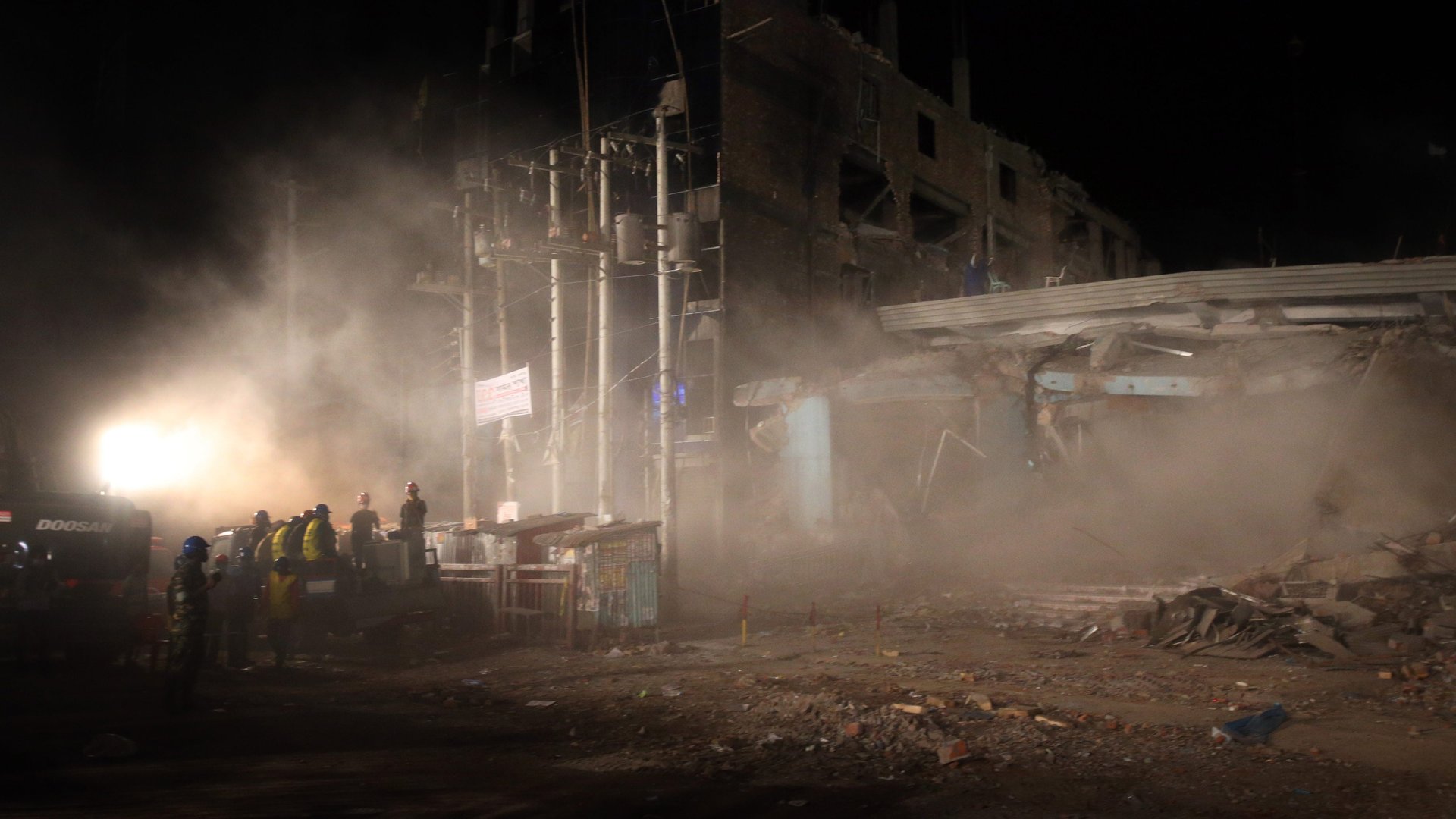Want to improve working conditions in Bangladesh? Boycott the Gap
Updated 7:30 pm ET.


Updated 7:30 pm ET.
The news from Rana Plaza, the collapsed Bangladesh factory, keeps getting worse. The death toll has reached 430, with 129 still missing—and as more facts emerge it is growing clear that the tragedy could have been averted. But figuring out how to prevent the next disaster is anything but easy.
The country is a giant textile exporter—second only to China—and it owes its position primarily to its desperate poverty, which has resulted in the world’s lowest factory wages. The Bangladeshi government has been unable to enact any meaningful safety reforms to prevent horrific factory fires and cave-ins. And most of the world’s major clothing companies seem unwilling to change their manufacturing practices in any meaningful way.
What’s a concerned consumer to do?
Some have suggested that cheap clothes themselves are the problem—that $2 t-shirts are inherently incompatible with ethical manufacturing. But in fact the manufacture of cheap clothes can help poor people—even at minimum wages of $37 a month that the pope called “slave labor” this week. Stephanie Nolen, South Asia bureau chief for The Globe and Mail, wrote an incisive essay arguing that “our cheap clothes have helped fuel a social and economic revolution in Bangladesh, and Bangladeshis do not want that to end.” The millions of textile workers in Bangladesh are almost all women, and working for even scant wages has pulled countless people out of poverty. The same is true in other low-cost textile manufacturing centers like China and Vietnam.
Others have floated the idea of boycotting Bangladeshi products altogether until the country cleans up its act. However, there is little evidence that the government possesses sufficient power to enact far-reaching changes in manufacturing standards. Bangladesh’s society is riddled with corruption and bitterly divided—aside from protests over the Rana Plaza collapse, the country has been repeatedly paralyzed by strikes by the country’s opposition Islamist party, and riven by religious violence.
Cutting off the country’s only substantial source of foreign capital would likely only make the chaos worse. “We certainly don’t want the brands leaving Bangladesh,” Judy Gearheart, executive director of the International Labor Rights Forum, told NPR this week (audio). “The point is to clean up the industry, not to walk away from the mess.”
Which leaves us with the multinational corporations who have made Bangladesh their go-to low-cost workshop. They have the negotiating power and operational wherewithal to make sure—not with 100% certainty, but approaching it—that their clothes are being produced at facilities with the proper worker safeguards.
This is not complicated stuff. It is spelled out in plain language in the Bangladesh Fire and Building Safety Agreement, drafted by trade unions and labor rights organizations in the wake of the last disaster to befall the Bangladeshi textile industry: the 2012 fire at the Tazreen Fashion factory that killed at least 117 people. The AP reports:
The plan would ditch government inspections, which are infrequent and easily subverted by corruption, and establish an independent inspectorate to oversee all factories in Bangladesh, with powers to shut down unsafe facilities as part of a legally binding contract signed by suppliers, customers and unions. The inspections would be funded by contributions from the companies of up to $500,000 per year.
But manufacturers refused to sign onto the agreement in 2011, and it is not hard, in a cold-hearted business sense, to understand why. A single, comprehensive safety regimen eliminates the wiggle room that many companies find desirable. If every company can design its own compliance scheme—as opposed to a commonly agreed standard—it produces a patchwork of safeguards that is impossible for even the most dedicated consumer to untangle.
The agreement won’t go into effect until at least four major clothing manufacturers sign on. So far there have been only two: PvH, which owns brands including Calvin Klein and Tommy Hilfiger, and German retailer Tchibo. That leaves two to go—which brings us to a simple way that consumers can actually do something constructive in response to the Rana Plaza disaster.
Concerned consumers don’t have to organize boycotts against every one of the dozens of multinational textile manufacturers in Bangladesh, or refuse to buy any clothing with the country’s name on the label. They only have to strategically target a handful of companies, and then opt to spend their clothing allowance with companies that are signatories.
Who to target? The list is long, but there is one company that stands out: the Gap, which has long benefitted from its socially responsible corporate aura. It did not have any production facilities at Rana Plaza, but its contractors were present at the 2011 Tazreen fire. The Gap is ubiquitous in the United States and Europe, has shown a willingness in the past to change in the face of social pressure, and is seen as a leader in the global textile business.
And this is the kicker: the Gap was the highest-profile walkout from the 2011 negotiations over the fire and safety agreement. As the Associated Press put it, a Gap spokesman in December explained that it “turned down the proposal because it did not want to be vulnerable to lawsuits and did not want to pay factories more money to help with safety upgrades.”
Does that rationale really fly in the wake of this tragedy?
Gap Inc. said in a statement in response to our queries that it had set up a fire and workplace safety program with its Bangladesh suppliers in October and is talking with other organizations about ways to bring improvements to worker safety. Systemic change “will require the participation of multiple brands, the US and European governments, the International Labor Organization, and the local stakeholders—government, industry and worker representatives in Bangladesh,” the Gap’s statement said. “We believe that this can be done.”